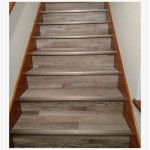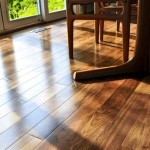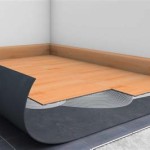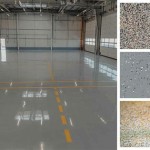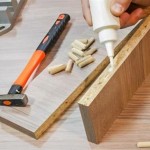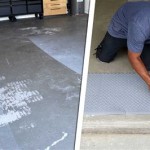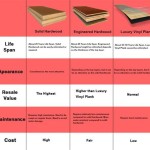Best Ways to Remove Tape Residue From Wood Floors
Tape residue on wood floors is a common problem that can arise from various situations, including renovations, temporary repairs, or even children's play. The adhesive left behind can be unsightly, sticky, and attract dirt, diminishing the aesthetic appeal of the floor. Addressing this issue effectively requires understanding the nature of the adhesive and employing appropriate removal techniques that will not damage the wood's finish. It is crucial to approach the removal process with patience and caution, using the least aggressive methods first to avoid irreversible damage to the flooring.
The type of wood flooring (e.g., hardwood, engineered wood, laminate) and the finish applied (e.g., polyurethane, varnish, oil-based) significantly influence the selection of cleaning agents and methods. Some solutions that are safe for one type of floor may cause damage to another. Therefore, identifying the type of flooring and finish is the first step in choosing the appropriate removal strategy. Ignoring this critical step can lead to discoloration, scratching, or even the complete stripping of the protective layer.
Before applying any cleaning solution to the entire affected area, it is always recommended to test it on an inconspicuous spot. This will help determine if the solution will damage or discolor the finish. Select a small, hidden area, such as under a piece of furniture or in a closet, to conduct the test. Apply the chosen solution sparingly, let it sit for a few minutes, and then wipe it away. Observe the area for any adverse reactions, such as changes in color, texture, or gloss. If no damage occurs, proceed with applying the solution to the tape residue.
Using Heat to Soften Adhesive
Heat is often an effective first step in loosening the adhesive bond of tape residue. The application of heat softens the adhesive, making it easier to peel away without damaging the wood floor. There are several ways to apply heat, with a hairdryer being one of the most readily available and controllable options. When utilizing a hairdryer, it is essential to maintain a safe distance from the floor to prevent overheating, which could potentially damage the finish. Direct the warm air onto the residue for several seconds, periodically checking to see if the adhesive is softening. Once softened, gently scrape away the residue with a plastic scraper or a credit card, taking care not to scratch the wood surface.
Another potential heat source is a warm, damp cloth. Soaking a cloth in warm water and placing it over the residue can help to soften the adhesive. Ensure the cloth is not excessively wet, as prolonged exposure to moisture can damage wood floors. After a few minutes, lift the cloth and try to wipe away the residue. This method is particularly useful for delicate finishes that may be more susceptible to damage from direct heat or harsh chemicals. It is crucial to dry the area thoroughly after using a damp cloth to prevent water damage.
When employing heat, it's vital to monitor the wood floor for any signs of damage. If the finish begins to bubble or discolor, immediately discontinue the use of heat and explore alternative methods. The goal is to soften the adhesive without causing any harm to the underlying wood or its protective coating. Gentle and controlled heat application is key to achieving the desired outcome.
Employing Solvents and Cleaning Agents
If heat alone is insufficient to remove the tape residue, various solvents and cleaning agents can be utilized. It's important to select a solvent that is effective at dissolving adhesive without harming the wood finish. Isopropyl alcohol, commonly known as rubbing alcohol, is often a good starting point. It is generally safe for most wood finishes and can effectively break down many types of adhesives. Apply a small amount of isopropyl alcohol to a clean cloth and gently rub the residue. Avoid pouring the alcohol directly onto the floor. Allow the alcohol to sit for a few minutes to dissolve the adhesive before wiping it away. Repeat the process as necessary until the residue is completely removed.
Another option is mineral spirits, also known as white spirit. Mineral spirits are stronger than isopropyl alcohol and may be necessary for stubborn residue. However, mineral spirits can damage some wood finishes, so testing on an inconspicuous area is crucial before widespread application. Apply mineral spirits sparingly to a clean cloth and gently rub the residue. Ensure adequate ventilation while using mineral spirits, as they can emit fumes. After removing the residue, clean the area with a damp cloth to remove any remaining solvent.
Commercial adhesive removers are also available and formulated specifically for removing sticky residue. These products often contain a blend of solvents and other ingredients designed to break down adhesive without damaging surfaces. When using a commercial adhesive remover, carefully follow the manufacturer's instructions. As with other solvents, test the product on an inconspicuous area before applying it to the tape residue. Ensure adequate ventilation and wear gloves to protect your skin.
For more natural alternatives, consider using vinegar or a mixture of baking soda and oil. Vinegar is a mild acid that can help dissolve some adhesives. Dilute white vinegar with water and apply it to the residue using a clean cloth. Let it sit for a few minutes before wiping it away. A paste of baking soda and oil (such as olive oil or vegetable oil) can also be effective. The oil helps to loosen the adhesive, while the baking soda provides a gentle abrasive action. Apply the paste to the residue, let it sit for a few minutes, and then gently scrub it away with a soft cloth.
Mechanical Removal Techniques
In cases where heat and solvents are not entirely successful, mechanical removal techniques can be employed with caution. The key is to use tools and methods that will not scratch or damage the wood finish. A plastic scraper or a credit card can be used to gently scrape away softened residue. Hold the scraper at a low angle to the floor and apply gentle pressure, working in small sections. Avoid using metal scrapers or abrasive pads, as these can easily scratch the wood surface. Regularly clean the scraper to prevent the buildup of adhesive, which could also cause scratching.
Another option is to use a soft cloth or microfiber towel to buff away the residue. Dampen the cloth slightly with water or a mild cleaning solution and gently rub the residue in a circular motion. This method is particularly effective for removing thin layers of adhesive or residue that has been softened by other methods. Avoid applying excessive pressure, as this could damage the finish.
For particularly stubborn residue, consider using a specialized adhesive removal tool. These tools are designed to remove adhesive without damaging surfaces. They typically feature a soft, flexible head that conforms to the shape of the surface and a non-abrasive cleaning pad. Follow the manufacturer's instructions for use and test the tool on an inconspicuous area before applying it to the tape residue.
After removing the tape residue, it is essential to clean the area thoroughly. Use a damp cloth and a mild wood floor cleaner to remove any remaining solvent or cleaning agent. Dry the area completely with a clean cloth to prevent water damage. Inspect the floor for any signs of damage, such as scratches or discoloration. If necessary, apply a wood polish or restorer to enhance the finish and protect the wood.
Preventing future tape residue problems is always preferable to dealing with the aftermath. When using tape on wood floors, choose low-tack adhesive tapes specifically designed for delicate surfaces. Avoid leaving tape on the floor for extended periods, as this increases the likelihood of residue being left behind. When removing tape, pull it slowly and at a low angle to minimize the chance of adhesive transfer. Consider using alternative methods for securing items to the floor, such as non-slip mats or furniture pads.
The successful removal of tape residue from wood floors hinges on careful assessment, appropriate tool selection, and patient execution. Starting with the gentlest methods and progressing to more assertive ones, while always testing in an inconspicuous area first, will minimize the risk of damage. By following these guidelines and prioritizing the integrity of the floor’s finish, one can effectively eliminate unsightly residue and restore the floor to its original condition.

The Best Way To Remove Tape Residue From Hardwood Flooring Between Naps On Porch

4 Ways To Remove Adhesive From A Hardwood Floor Wikihow

Best Cleaner Ever To Remove Sticky Tape From Floors Etc Safe Easy

Easy Ways To Get Rid Of Carpet Tape On Wooden Floors Or Stairs Floor Sanding

Removing Carpet Tape From Hardwood Floors Or Stairs

How To Remove Duct Tape Residue

How To Remove Tape Residue From My Wood Floor Knowledge Centre

4 Ways To Remove Adhesive From A Hardwood Floor Wikihow

How To Remove Glue From Wood Floors Pete S

Best Cleaner Ever To Remove Sticky Tape From Floors Etc Safe Easy
See Also

